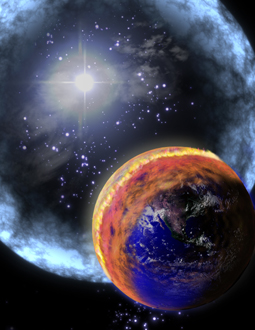 Gamma-ray
bursts — the death throes of a dying star — are the most powerful
explosions in the universe. Often when massive stars collapse in on themselves,
they eject two giant plumes of high-energy radiation from opposite poles.
Gamma-ray
bursts — the death throes of a dying star — are the most powerful
explosions in the universe. Often when massive stars collapse in on themselves,
they eject two giant plumes of high-energy radiation from opposite poles. In this artistís conception, gamma rays from a massive star explosion hit Earthís atmosphere. The expanding shell is pictured as blue, but gamma rays are actually invisible. Scientists say that a gamma-ray burst might have triggered the ice age that caused the Ordovician extinction 450 million years ago. Image courtesy of NASA.
Given the incidence of gamma-ray bursts in the cosmos, astrophysicists estimate that at least once in the last billion years, a burst has occurred within about 6,500 light years of Earth. Now, astrophysicists at the University of Kansas and NASA Goddard Space Flight Center report that if directed at Earth, such a blast could have prompted the ice age and resulting mass extinction during the late Ordovician, 443 million years ago.
The second largest extinction event in Earth’s history, the Ordovician event killed off 60 percent of all marine invertebrates and is believed to have been caused by the sudden onset of an ice age. However, paleo-climatologists remain uncertain about what triggered the ice age during a warm period with high carbon dioxide levels.
“We are not trying to supplant the glaciation hypothesis,” says Brian Thomas, a graduate student in astrophysics at the University of Kansas, Lawrence, and an author of the study in the April 1 Astrophysical Journal Letters. “That’s a reasonable reason for the extinction, and we know that there was a cooling event at the time. What we’re basically suggesting is that the gamma-ray burst started this event.”
Thomas and his team modeled what they estimated to be the most probable burst — a 10-second-long blast delivering 100 kilojoules of energy per square meter. In the weeks following such a burst, the model showed an average global ozone depletion of 35 percent, reaching as high as 55 percent at some latitudes. More than five years later, depletion was still about 10 percent.
Gamma-ray bursts break down nitrogen, which reacts with oxygen to form nitric oxide and destroys ozone. The reaction also produces nitrogen dioxide, a major component of smog, which again reacts with oxygen to form nitric oxide. This cycle perpetuates ozone destruction and produces more smog, blocking sunlight and triggering an ice age, the researchers say.
The team calculated that a 50 percent decrease in ozone would allow up to three times as much solar ultraviolet B (UVB) radiation to reach the surface. Additionally, Thomas says, “the initial flash would deliver the equivalent of five times the UVB flux of a normal, sunny summer day.”
By extrapolating from data on modern Antarctic phytoplankton exposed to increased UVB by ozone loss over the South Pole, the group concluded that a burst of this size and proximity could likely cause widespread extinctions by affecting the base of the marine food chain.
William Berry, a paleontologist at the University of California, Berkeley, however, notes that because very little is known about marine food chains of the Ordovician and because the paleontological record for the period is sparse, such extrapolations are tentative at best. “What was floating out there wasn’t really modern phytoplankton, so we can’t really say whether that will apply to the Ordovician or not,” Berry says. “We just don’t have the evidence.”
Some previous studies looked to other organisms for evidence. In 2003, Thomas’ co-author, astrophysicist Adrian Melott, and paleontologist Bruce Lieberman, both of the University of Kansas, reported finding higher extinction rates among shallow marine trilobites in the Ordovician. And that finding, they say, is consistent with what would happen with an influx of radiation from a gamma-ray burst, as UVB does not penetrate deep water, having a greater effect on land and shallow-water dwellers.
However, other researchers have noted that lower sea level due to glaciation could also explain any disproportionate impact on shallow-marine organisms. Additionally, Berry says that bias in the fossil record must be taken into consideration.
“Most of the fossil record is in rocks deposited in relatively shallow waters,” Berry says, so most of the studies are of shallow organisms. But even in the deep-water record, which he says is “pretty slim,” there is evidence that some members of families went extinct while others survived. Such complexities emphasize that extinction patterns are difficult to explain using habitat depth alone.
Thomas says that although more studies need to be done, searching for evidence of a gamma-ray burst in the geologic record would be quite difficult. Unlike asteroids or supernovae, the bursts are not expected to leave behind any direct evidence. So, if a chemical signature of a cosmic event were to be found at the end of the Ordovician, it would rule out the gamma-ray burst idea — and could point to another cause for the extinction.
Sara Pratt
Geotimes contributing writer

